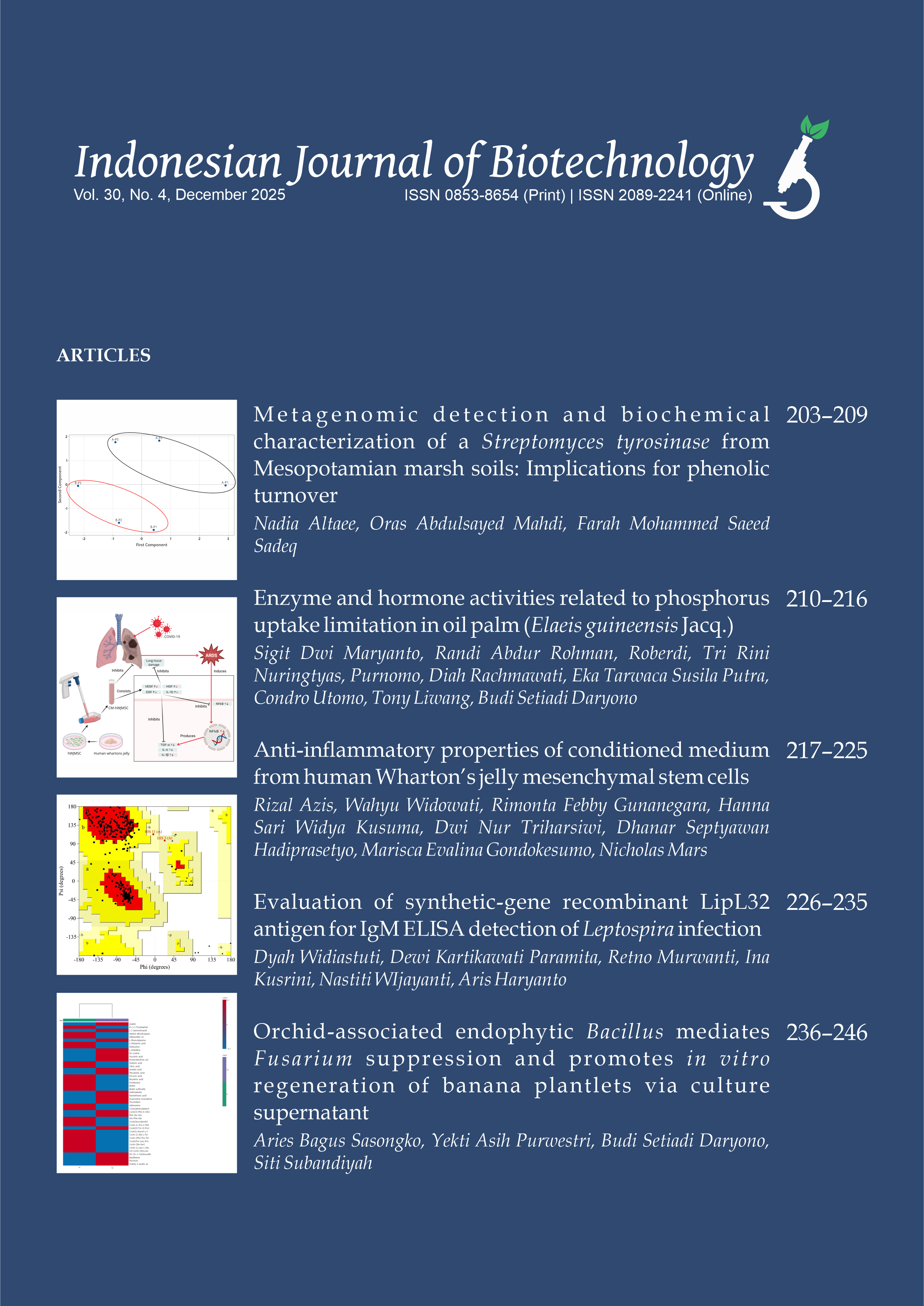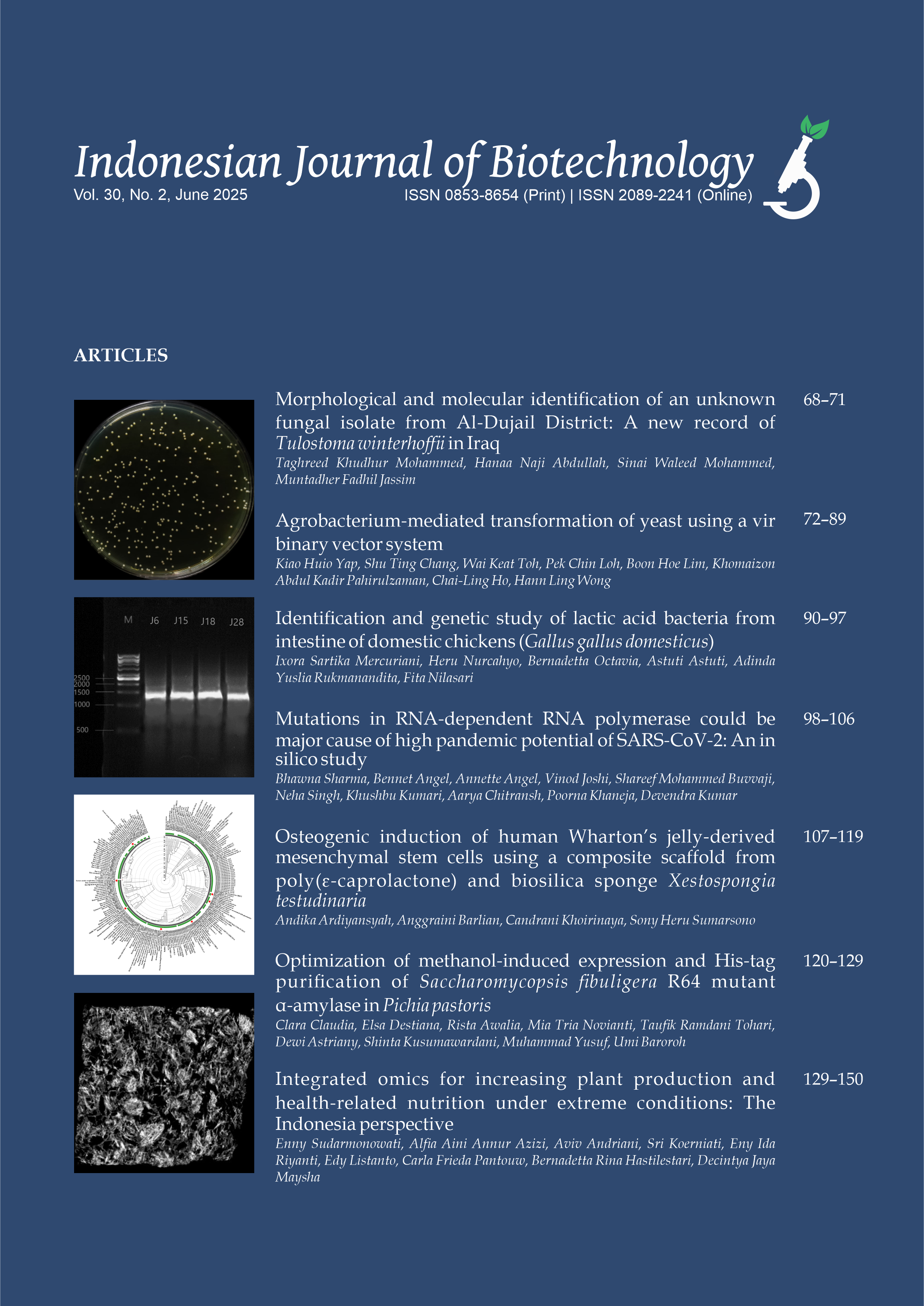Identification of mercury‐resistant Streptomyces isolated from Cyperus rotundus L. rhizosphere and molecular cloning of mercury (II) reductase gene
Wahyu Aristyaning Putri(1), Hanum Mukti Rahayu(2), Anis Uswatun Khasanah(3), Langkah Sembiring(4), Masashi Kawaichi(5), Yekti Asih Purwestri(6*)
(1) Biotechnology Laboratory, Department of Tropical Biology, Faculty of Biology, Universitas Gadjah Mada. Jl. Teknika Selatan, Sekip Utara, Bulaksumur Yogyakarta 55281, Indonesia
(2) Program of Biology Education, Faculty of Teacher Training and Education, Universitas Muhammadiyah Pontianak. Jl. Ahmad Yani No. 111 Pontianak 78124, West Kalimantan, Indonesia
(3) Biology Laboratory, Program of Biology, Department of Science, UIN Sultan Maulana Hasanuddin Banten. Jl. Jalan Jendral Sudirman No. 30 Panancangan Cipocok Jaya, Sumurpecung, Kec. Serang, Kota Serang, Banten 42118, Indonesia
(4) Microbiology Laboratory, Department of Tropical Biology, Faculty of Biology, Universitas Gadjah Mada. Jl. Teknika Selatan, Sekip Utara, Bulaksumur Yogyakarta 55281, Indonesia
(5) Division of Gene Function in Animals, Nara Institute of Science and Technology, Ikoma, 630‐0192, Japan
(6) Biochemistry Laboratory, Department of Tropical Biology, Faculty of Biology, Universitas Gadjah Mada. Jl. Teknika Selatan, Sekip Utara, Bulaksumur Yogyakarta 55281, Indonesia
(*) Corresponding Author
Abstract
Streptomyces is one of mercury‐resistant bacteria which can convert Hg2+ into nontoxic Hg0 . This study aimed to identify mercury‐resistant Streptomyces present in the Cyperus rotundus rhizosphere from artisanal small‐scale gold mining (ASGM) area and clone merA gene to the cloning and expression vectors. Molecular identification was conducted using 16s rRNA gene with the maximum likelihood algorithms. Results revealed that the AS1 and AS2 strains were a group of Streptomyces ardesiacus and the BR28 strain was closed to Brevibacillus agri. The AS2 merA gene was cloned to pMD20 cloning vectors, pGEX‐5x‐1 and pET‐28c expression vectors. The transformation was successfully performed in BL21 and DH5α competent cells. The full length of the merA gene was confirmed to be 1,425 bp. This study is the first research on identifying mercury‐resistant Streptomyces and cloning the full‐length merA gene in Indonesia.
Keywords
Full Text:
PDFReferences
Alotaibi BS, Khan M, Shamim S. 2021. Unraveling the underlying heavy metal detoxification mechanisms of bacillus species. Microorganisms. 9(8). doi:10.3390/microorganisms9081628.
Anggoro RR, Ratnaningsih E. 2018. Expression of haloacid dehalogenase gene and its molecular protein characterization from Klebsiella pneumoniae ITB1. Indones J Biotechnol. 22(1):1. doi:10.22146/ijbiotech.26004.
Boyd ES, Barkay T. 2012. The mercury resistance operon : from an origin in a geothermal environment to an efficient detoxification machine. Front Microbiol. 3(10):1–13. doi:10.3389/fmicb.2012.00349.
Chasanah U, Nuraini Y, Handayanto E. 2018. The potential of mercury-resistant bacteria isolated from small-scale gold mine tailings for accumulation of mercury. J Ecol Eng. 19(2):236–245. doi:10.12911/22998993/83565.
Fatimawali, Kepel B, Yusuf I, Badaruddin F, Natsir R, Retnoningrum D. 2014. Isolation and Characterization of Partial Sequence of merA Gene from Mercury Resistant Bacterium Klebsiella pneumoniae Isolated from Sario River Estuary Manado. Res J Environ Earth Sci. 6(3):156–160. doi:10.19026/rjees.6.5754.
Fatimawali, Kepel BJ, Gani MA, Tallei TE. 2020. Comparison of Bacterial Community Structure and Diversity in Traditional Gold Mining Waste Disposal Site and Rice Field by Using a Metabarcoding Approach. Int J Microbiol. 1(1):1–8. doi:10.1155/2020/1858732.
Imron MF, Kurniawan SB, Soegianto A. 2019. Characterization of mercury-reducing potential bacteria isolated from Keputih non-active sanitary landfill leachate, Surabaya, Indonesia under different saline conditions. J. Environ. Manage. 241:113–122. doi:10.1016/j.jenvman.2019.04.017.
Hopwood D. 1983. Cloning and Expression of the Tyrosinase Gene from Streptomyces antibioticus in Streptomyces lividans. J Gen Microbiol. 129(4):2703–2714. doi:10.1099/00221287-129-9-2703.
Krisnayanti BD, Anderson CWN, Utomo H, Feng X. 2012. Assessment of environmental mercury discharge at a four-year-old artisanal gold mining area on Lombok Island , Indonesia. J Environ Monit. 14(8):2598–2607. doi:10.1039/c2em30515a.
Kumar S, Stecher G, Li M, Knyaz C, Tamura K. 2018. MEGA X: Molecular evolutionary genetics analysis across computing platforms. Mol Biol Evol. 35(6):1547–1549. doi:10.1093/molbev/msy096.
Krisnayanti BD, Anderson CWN, Utomo H, Feng X. 2012. Assessment of environmental mercury discharge at a four-year-old artisanal gold mining area on Lombok Island , Indonesia. Journal of Environmental Monitoring 14:2598–2607. doi:10.1039/c2em30515a.
Liebert CA, Hall RM, Summers AO. 1999. Transposon Tn 21 , Flagship of the Floating Genome. Am Soc Microbiol. 63(3):507–522. doi:10.1128/MMBR.63.3.507-522.1999.
Marko MA, Chipperfield R, Birnboim HC. 1982. A procedure for the large-scale isolation of highly purified plasmid DNA using alkaline extraction and binding to glass powder. Anal Biochem. 121(2):382–387. doi:10.1016/0003-2697(82)90497-3.
Mosa KA, Saadoun I, Kumar K, Helmy M. 2016. Potential Biotechnological Strategies for the Cleanup of Heavy Metals and Metalloids. Front Plant Sci. 7(3):1–14. doi:10.3389/fpls.2016.00303.
Niane B, Devarajan N, Poté J, Moritz R. 2019. Quantification and characterization of mercury resistant bacteria in sediments contaminated by artisanal small-scale gold mining activities, Kedougou region, Senegal. J Geochemical Explor. 205(8):0375–6742. doi:10.1016/j.gexplo.2019.106353.
Oregaard G, Sorensen JS. 2007. High diversity of bacterial mercuric reductase genes from surface and sub-surface floodplain soil. ISME J. 1(7):453–467. doi:10.1038/ismej.2007.56.
Purkan P, Nuzulla YF, Hadi S, Prasetyawati ET. 2017. Biochemical Properties of Mercuric Reductase from Local Isolate of Bacillus sp for Bioremediation Agent. Molekul. 12(2):182–188. doi:10.20884/1.jm.2017.12.2.398.
Rahayu HM, Putri WA, Khasanah AU, Sembiring L, Purwestri YA. 2021. Indigeneous streptomyces spp. Isolated from cyperus rotundus rhizosphere indicate high mercuric reductase activity as a potential bioremediation agent. Biodiversitas. 22(3):1519–1525. doi:10.13057/biodiv/d220357.
Santorum JM, Darriba D, Taboada GL, Posada D. 2014. Jmodeltest.org: Selection of nucleotide substitution models on the cloud. Bioinformatics 30(9):1310– 1311. doi:10.1093/bioinformatics/btu032.
Singh S, Kumar V. 2020. Mercury detoxification by absorption, mercuric ion reductase, and exopolysaccharides: a comprehensive study. Environ Sci Pollut Res. 27(22):27181–27201. doi:10.1007/s11356-019-04974-w.
Thompson JD, Higgins DG, Gibson TJ. 1994. CLUSTAL W: Improving the sensitivity of progressive multiple sequence alignment through sequence weighting, position-specific gap penalties and weight matrix choice. Nucleic Acids Res. 22(22):4673–4680. doi:10.1093/nar/22.22.4673.
Tiodar ED, Văcar CL, Podar D. 2021. Phytoremediation and microorganisms-assisted phytoremediation of mercury-contaminated soils: Challenges and perspectives. Int J Environ Res Public Health. 18(5):1–38. doi:10.3390/ijerph18052435.
Winardi W, Haryono E, Sudrajat S, Soetarto ES. 2020. In Situ Bioremediation Strategies for the Recovery of Mercury- contaminated Land in Abandoned Traditional Gold Mines in Indonesia. Biosaintifika. 12(3):469–477. doi:10.15294/biosaintifika.v12i3.25229.
Xiao-xi Z, Jian-xin T, Pei J. 2010. Isolation, characterization and extraction of mer gene of Hg2+ resisting strain D2. Trans Nonferrous Met Soc China. 20(12):507–512. doi:10.1016/S1003-6326(09)60170-9.
Zhang NX, Guo Y, Li H, Yang XQ, Gao CX, Hui CY. 2021. Versatile artificial mer operons in Escherichia coli towards whole cell biosensing and adsorption of mercury. PLoS One. 16(5):1–14. doi:10.1371/journal.pone.0252190.
Zulaika E, Sembiring L. 2015. Mercury reductase activity of an indigenous mercury resistant bacterial isolate (Bacillus sp. S1) from Kalimas-Surabaya as a potential Reducing Agent for Mercurial Ion (Hg2+). In: The 3rd ICBS-2013 Proceeding. Vol. 2. KnE Life Sciences. p. 446–450.
Article Metrics
Refbacks
- There are currently no refbacks.
Copyright (c) 2021 The Author(s)

This work is licensed under a Creative Commons Attribution-ShareAlike 4.0 International License.









